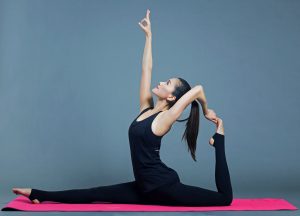
Introduction:
Yoga is a wonderful practice that offers numerous physical and mental benefits. It is an ancient art form that originated in India and has been gaining popularity worldwide due to its positive effects on overall well-being. Whether you are a beginner or an experienced practitioner, incorporating yoga into your daily routine can significantly improve your flexibility, strength, and peace of mind. In this blog, we will explore ten easy yoga poses suitable for beginners, along with their benefits and step-by-step instructions.
1. Mountain Pose (Tadasana):
Mountain Pose is the foundational yoga pose that sets the tone for many other postures. It involves standing tall with your feet hip-width apart and palms by your sides. Benefits include improved posture, increased body awareness, and enhanced focus.
Steps:
- Stand with feet hip-width apart.
- Keep your spine straight and shoulders relaxed.
- Inhale deeply as you raise your arms overhead, palms facing each other.
- Hold the pose for 30 seconds to 1 minute, breathing deeply.
2. Downward Facing Dog (Adho Mukha Svanasana):
This iconic pose is excellent for stretching the entire body and strengthening the arms and legs. It also calms the mind and reduces stress.
Steps:
- Start on your hands and knees, aligning wrists under shoulders and knees under hips.
- Tuck your toes and lift your hips up and back, forming an inverted V-shape.
- Press firmly into your palms and heels while engaging your core.
Hold for 5 to 10 breaths, gradually increasing the duration with practice.
3. Child’s Pose (Balasana):
The Child’s Pose is a relaxing and restorative posture that stretches the lower back and hips. It helps alleviate stress and fatigue, making it an ideal pose to practice between challenging poses.
Steps:
- Kneel on the floor with your big toes touching and your knees spread wide.
- Sit back on your heels and exhale as you lower your torso between your thighs.
- Extend your arms forward or rest them alongside your body.
Breathe deeply and hold the pose for 1 to 2 minutes.
4. Cobra Pose (Bhujangasana):
Cobra Pose strengthens the back muscles and improves spine flexibility. It also stimulates abdominal organs and helps alleviate mild back pain.
Steps:
- Lie flat on your stomach with legs extended, and palms under your shoulders.
- Inhale deeply as you lift your head, chest, and abdomen off the mat.
- Keep your elbows close to your body and shoulders relaxed.
Hold the pose for 15 to 30 seconds, breathing smoothly.
5. Seated Forward Bend (Paschimottanasana):
This seated pose stretches the entire back and hamstrings, promoting flexibility in the spine. It also aids digestion and calms the mind.
Steps:
- Sit with your legs extended in front of you.
- Inhale deeply and lengthen your spine.
- Exhale as you hinge at the hips and reach for your toes.
- Hold the pose for 30 seconds, breathing steadily.
6. Bridge Pose (Setu Bandhasana):
Bridge Pose strengthens the back, glutes, and legs while also opening the chest. It helps reduce anxiety and fatigue.
Steps:
- Lie on your back with knees bent and feet flat on the floor, hip-width apart.
- Inhale, press your feet into the floor, and lift your hips off the ground.
- Interlace your fingers beneath your back and straighten your arms.
- Hold the pose for 20 to 30 seconds, breathing deeply.
7. Warrior I (Virabhadrasana I):
Warrior I builds strength in the legs and stretches the chest and shoulders. It also promotes focus and determination.
Steps:
- Start in a lunge position with your right foot forward and left foot back.
- Rotate your back foot to a 45-degree angle and bend your right knee.
- Inhale as you raise your arms overhead, palms facing each other.
- Hold the pose for 30 seconds, then switch sides.
8. Tree Pose (Vrikshasana):
Tree Pose improves balance and concentration while strengthening the legs and ankles. It also opens the hips and stretches the inner thighs.
Steps:
- Stand tall with feet together and arms by your sides.
- Shift your weight onto your left foot and bring your right foot to your left inner thigh.
- Press your hands together in a prayer position at your chest.
Hold the pose for 20 to 30 seconds, then switch sides.
9. Corpse Pose (Savasana):
Corpse Pose is the final relaxation pose in most yoga practices. It helps release tension and induces a state of deep relaxation and meditation.
Steps:
- Lie on your back with your legs extended and arms by your sides, palms facing up.
- Close your eyes and let your body completely relax.
- Focus on your breath and let go of any thoughts or distractions.
Remain in Savasana for at least 5 minutes, gradually increasing the time with practice.
10. Cat-Cow Pose (Marjaryasana-Bitilasana):
Cat-Cow Pose is a gentle warm-up sequence that flexes and stretches the spine. It also massages the organs and improves digestion.
Steps:
- Start on your hands and knees in a tabletop position.
- Inhale as you arch your back, lifting your head and tailbone (Cow Pose).
- Exhale as you round your spine, tucking your chin (Cat Pose).
- Flow between the two poses for 1 to 2 minutes, syncing breath with movement.
Conclusion:
Incorporating these ten easy yoga poses into your daily routine can significantly improve your physical and mental well-being. As a beginner, take it slowly and listen to your body, ensuring you are comfortable in each pose. Yoga is a journey, and with consistent practice, you will gradually witness the transformative power of these ancient postures. Whether it’s the standing yoga poses that ground you or the advanced ones that challenge you, remember that the true essence of yoga lies in the union of mind, body, and spirit.
Remember to practice yoga in a space where you feel comfortable and free from distractions. Embrace the process, and enjoy the wonderful journey that yoga has to offer!






